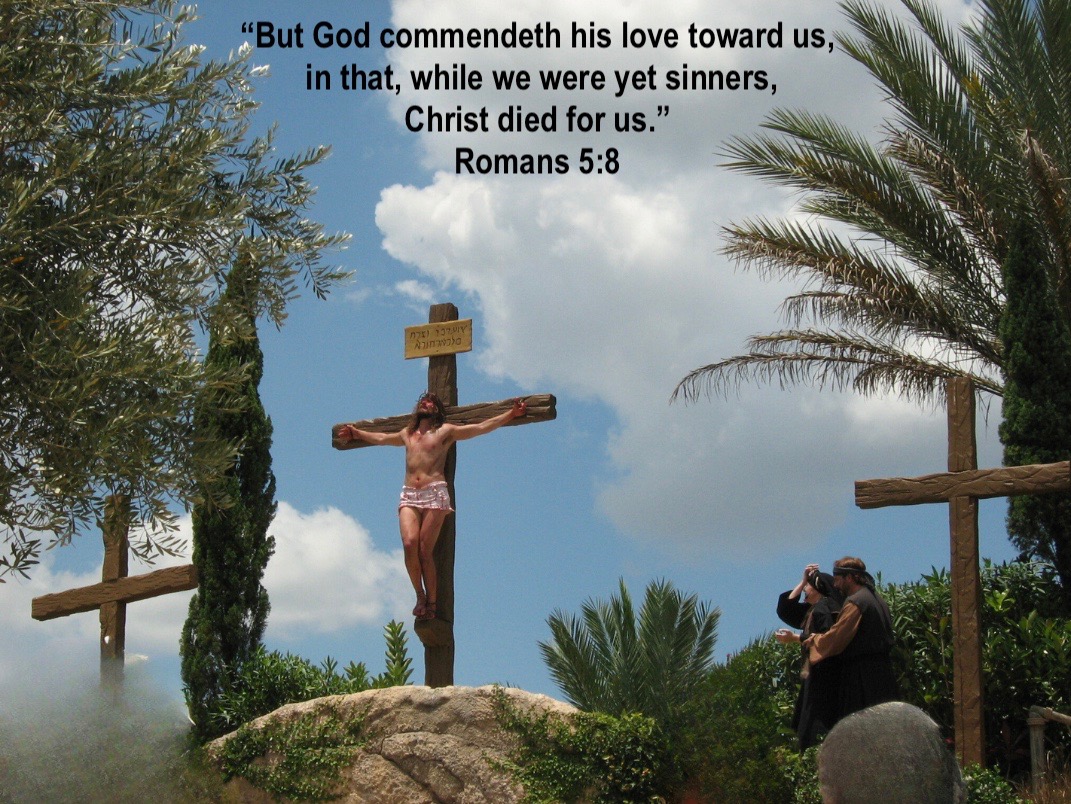
At the approximate age of 33, Jesus was condemned to death by crucifixion.
Crucifixion was a common method of executing criminals that dates back to the time of several ancient cultures including the Egyptians, Assyrians, Persians, and at the time of Christ, the Romans. It was a tortuous and excruciating way to die used by Rome to kill traitors, slaves, Christians, and political activists as well as other “enemies” of the state. Cause of death was from asphyxiation (suffocation), loss of bodily fluids, and massive organ failure.
The process of crucifixion involved two wooden beams to which a condemned man was affixed with nails and/or rope. The nails used by the Romans measured five to seven inches long and were driven through the wrists and feet to secure the victim to the cross. The executions always took place in a public area where the dying could be easily viewed by all.
In the case of Jesus’ crucifixion, nails were used in both the wrists and the feet to secure Him to the cross. According to various medical reports, searing pain would come from nerves in the wrists and feet damaged by the nails and from intense muscle cramping caused by fatigue and lack of oxygen.
Once suspended on a cross, Jesus’ unsupported body weight on His arms and shoulders made it virtually impossible to exhale fully after each breath, causing a slow and painful death from respiratory failure as the lungs were rendered incapable of adequately ventilating the body. Death would usually occur anywhere from 6 hours to a few days later, but in Jesus’ case, His death occurred anywhere from 3-6 hours after being crucified (Mark 15:25, 34). Historians speculate a quick demise, most likely due to the severity of the horrific scourging from the Romans.
The nails used to affix Jesus to the cross were hammered into his wrists, not the palms. There are two main reasons for this conclusion. The primary is that the palms were more fleshy than the wrist and would not support a weakened and dying body, leading to the ripping of the hands from the nails as the body sagged. The wrists have 7 bones in them that provided more stability and strength to keep the body on the cross. The second reason is that hammering into the wrists tear tendons which prevent the condemned from pulling themselves up to help draw in oxygen. The victims instead must try to use back muscles to enable chest expansion, scraping the already flogged and exposed torn muscles alongside the rough surface of the cross, which inflicts more pain and suffering.
The slow suffocation of crucifixion was caused by the inability of two sets of respiratory muscles to continue the breathing process effectively. As Jesus became progressively weaker, He would be unable to empty His lungs of carbon dioxide, and asphyxiation would ensue.
Prior to walking the long road to Golgotha, Jesus was mercilessly scourged by the Roman soldiers. “Then Pilate therefore took Jesus, and scourged him.” (John 19:1) This inhumane torture prior to His execution yielded extensive trauma to His body. The enormous amount of blood loss would have severely weakened Him before He went to the cross. Roman scourging could be so severe that flesh would be torn from the body resulting in massive bleeding. His face was pummeled by the soldiers as they mocked Him (Luke 22:63). His beard was ripped from His face (Isaiah 50:6), and a crown of thin sharp thorns was jammed onto His head (Matthew 27:29). All of this brutality led to dehydration and hypovolemic shock, which resulted in falling blood pressure, rapid heart rate, and accelerated respiration as the body tried to compensate for the traumatic loss of blood volume.
After this savage torture, Jesus was forced to carry the crossbeam part way to the site of His crucifixion. The preferred place for Roman crucifixion was outside of the main city along the road most commonly traveled. This site was chosen primarily to allow passersby to see the dying and to serve as a warning as to the punishment for those who dared to rise up against Rome.
For Jesus’ crucifixion, the main road connecting Jerusalem to Jericho, was most likely the place of His execution. Along this road was a place known as the “place of the skulls” where travelers coming to Jerusalem would be “head counted” for tax purposes by the officials. “And he bearing his cross went forth into a place called the place of a skull, which is called in the Hebrew Golgotha:” (John 19:14). Everyone passed this way to enter the city, and thus would see the condemned men hanging on the crosses as they neared Jerusalem.
Once the criminals were on the crosses, Roman guards stood by, forbidden to leave until the criminals were dead. This would often lead to the soldiers speeding up the death process by breaking the lower legs of the victims to prevent breathing, spearing them in the heart, delivering hard sharp blows to the chest, or building nearby fires to speed up asphyxiation.
In Jesus’ situation, the spear thrust by the Roman soldier entered the area near the heart, most likely releasing the clear fluid that accumulates around the heart or lungs as a result of heart failure, then penetrated the heart muscle itself to cause the outpouring of His blood. Scripture tells us “But one of the soldiers with a spear pierced his side, and forthwith came there out blood and water” (John 19:34).
On the cross, the convicted man was stripped either naked or down to minimal clothing adding humiliation to the physical anguish. Death by crucifixion was intended to be a slow and agonizing death with deep shame, unbearable pain, and maximum suffering. Jesus, the beloved and precious Son of God, endured this for me and for you, and the Bible tells us why.
- Romans 3:23 – “For all have sinned, and come short of the glory of God;”
- Romans 6:23 – “For the wages of sin is death; but the gift of God is eternal life through Jesus Christ our Lord.”
- Romans 5:8 – “But God commendeth his love toward us, in that, while we were yet sinners, Christ died for us.”
- John 3:16 – “For God so loved the world, that he gave his only begotten Son, that whosoever believeth in him should not perish, but have everlasting life.”
- Romans 10:9-10 – “That if thou shalt confess with thy mouth the Lord Jesus, and shalt believe in thine heart that God hath raised him from the dead, thou shalt be saved. For with the heart man believeth unto righteousness; and with the mouth confession is made unto salvation.”
- Romans 10:13 – “For whosoever shall call upon the name of the Lord shall be saved.”
The followers of Jesus were stunned into disbelief that this could have happened. They witnessed His death at the hands of the Romans. Their Messiah had been brutally executed. They fled and went into hiding afraid of their lives… afraid of their future. They had lost hope.
But it’s always darkest before the dawn.
Christ the Lord is risen today, Alleluia! Earth and heaven in chorus say, Alleluia!
Raise your joys and triumphs high, Alleluia! Sing, ye heavens, and earth reply, Alleluia!
Lives again our glorious King, Alleluia! Where, O death, is now thy sting? Alleluia!
Once he died our souls to save, Alleluia! Where’s thy victory, boasting grave? Alleluia!
Hail the Lord of earth and heaven, Alleluia! Praise to thee by both be given, Alleluia!
Thee we greet triumphant now, Alleluia! Hail the Resurrection, thou, Alleluia!
(from “Christ the Lord is Risen Today” by Charles Wesley)
“He is not here: for he is risen, as he said. Come, see the place where the Lord lay.” – Matthew 28:6
**********
Jesus died for me and for you. He’ll never force Himself upon you, but simply invites you to trust in what He did for you… paid the price for your sins on the cross… that you might have eternal life with Him one day in heaven. Won’t you trust Him today? If you have any questions about salvation, please send me a message. I’d love to share how you can come to know Him as your Saviour and Lord today!
